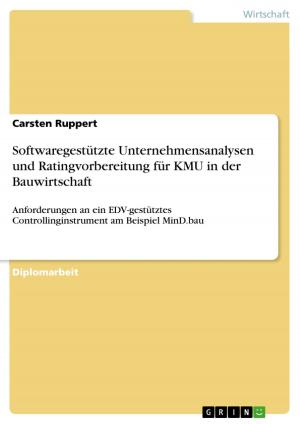Harvard Business School Case Study Tiffany & Co. - 1993
Business & Finance, Finance & Investing, Banks & Banking| Author: | Hagen Puschmann, Philipp Hauger, Julia Modlinskaia, Ahmet Kaya, Andre Merz | ISBN: | 9783638498067 |
| Publisher: | GRIN Verlag | Publication: | May 6, 2006 |
| Imprint: | GRIN Verlag | Language: | English |
| Author: | Hagen Puschmann, Philipp Hauger, Julia Modlinskaia, Ahmet Kaya, Andre Merz |
| ISBN: | 9783638498067 |
| Publisher: | GRIN Verlag |
| Publication: | May 6, 2006 |
| Imprint: | GRIN Verlag |
| Language: | English |
Research Paper (undergraduate) from the year 2005 in the subject Business economics - Banking, Stock Exchanges, Insurance, Accounting, grade: 92,5%, Frankfurt School of Finance & Management, 15 entries in the bibliography, language: English, abstract: In the context of Harvard Business Case Tiffany & Co. 1993 our team will focus on the Identification, Measurement, Management of the JPY/USD exchange rate in terms of Economic, Transaction and Translation Exposures for Tiffany & Co. 2. Economic Overview: Japan in 1993: In the decade of 1960s Japan faced various trade frictions with the USA and Europe in connection with rapid expansion of industrial products exports. In 1971, the USA decided to end the convertibility of the USD into gold. Therefore the fixed exchange rate regime (namely Bretton Woods System) was not in place anymore. Japan's reaction was to float its exchange rate from JPY 360 to JPY 308 in December 1971. In February 1973, the Japanese yen moved to the floating exchange-rate system. The Japanese Economy faced a steady growth until October 1973, as the Israeli-Arab War in this year lead to the first oil crisis, and it triggered a high inflation. As a result, Japan's economy recorded negative growth in 1974 for the first time in the post-war period
Research Paper (undergraduate) from the year 2005 in the subject Business economics - Banking, Stock Exchanges, Insurance, Accounting, grade: 92,5%, Frankfurt School of Finance & Management, 15 entries in the bibliography, language: English, abstract: In the context of Harvard Business Case Tiffany & Co. 1993 our team will focus on the Identification, Measurement, Management of the JPY/USD exchange rate in terms of Economic, Transaction and Translation Exposures for Tiffany & Co. 2. Economic Overview: Japan in 1993: In the decade of 1960s Japan faced various trade frictions with the USA and Europe in connection with rapid expansion of industrial products exports. In 1971, the USA decided to end the convertibility of the USD into gold. Therefore the fixed exchange rate regime (namely Bretton Woods System) was not in place anymore. Japan's reaction was to float its exchange rate from JPY 360 to JPY 308 in December 1971. In February 1973, the Japanese yen moved to the floating exchange-rate system. The Japanese Economy faced a steady growth until October 1973, as the Israeli-Arab War in this year lead to the first oil crisis, and it triggered a high inflation. As a result, Japan's economy recorded negative growth in 1974 for the first time in the post-war period















